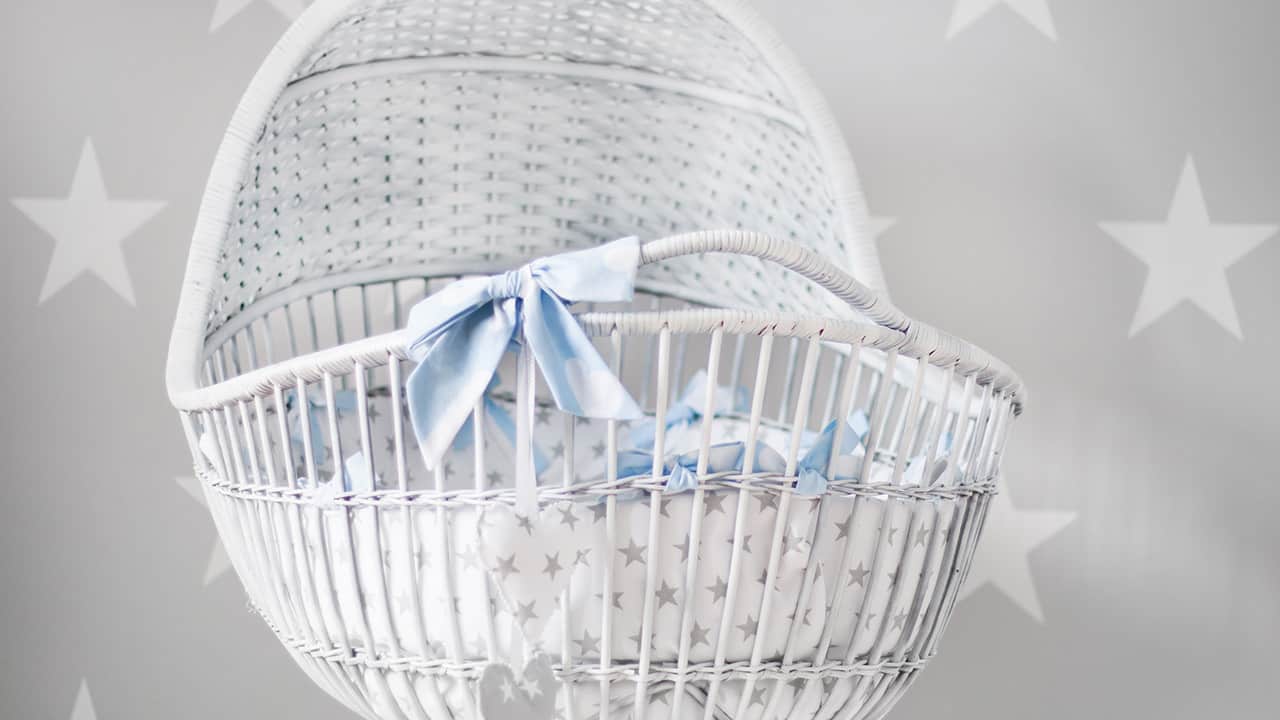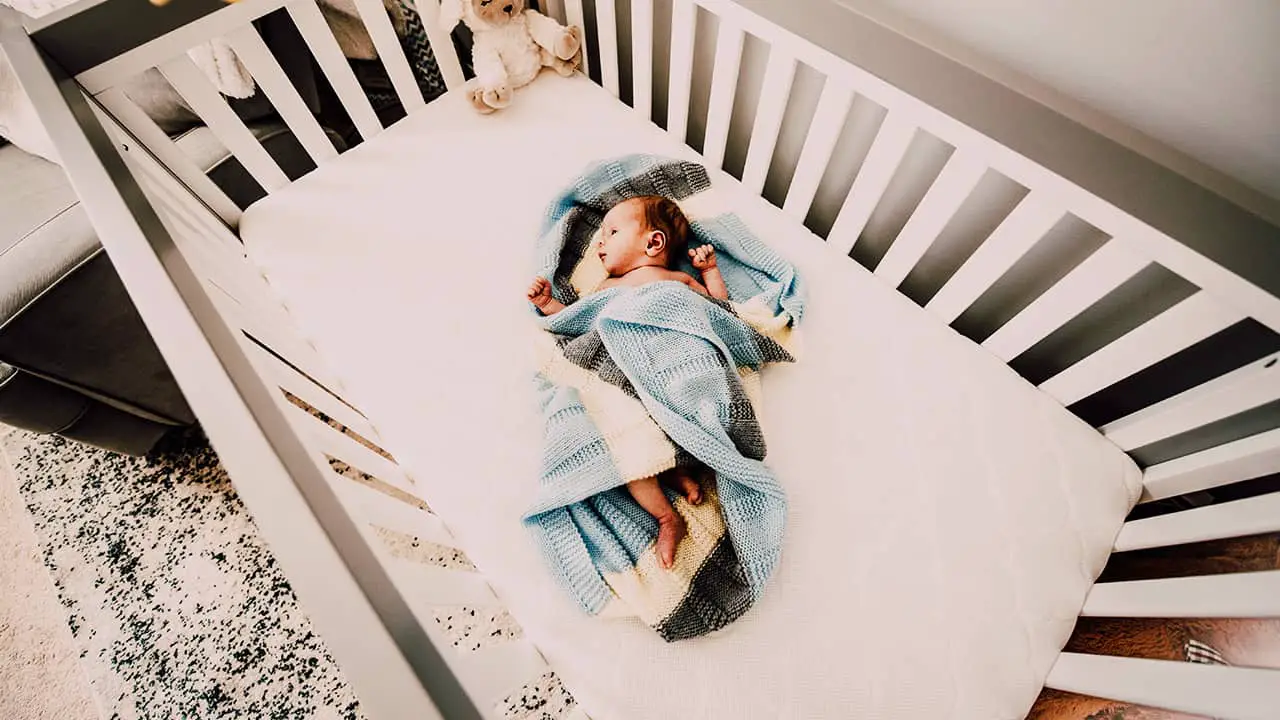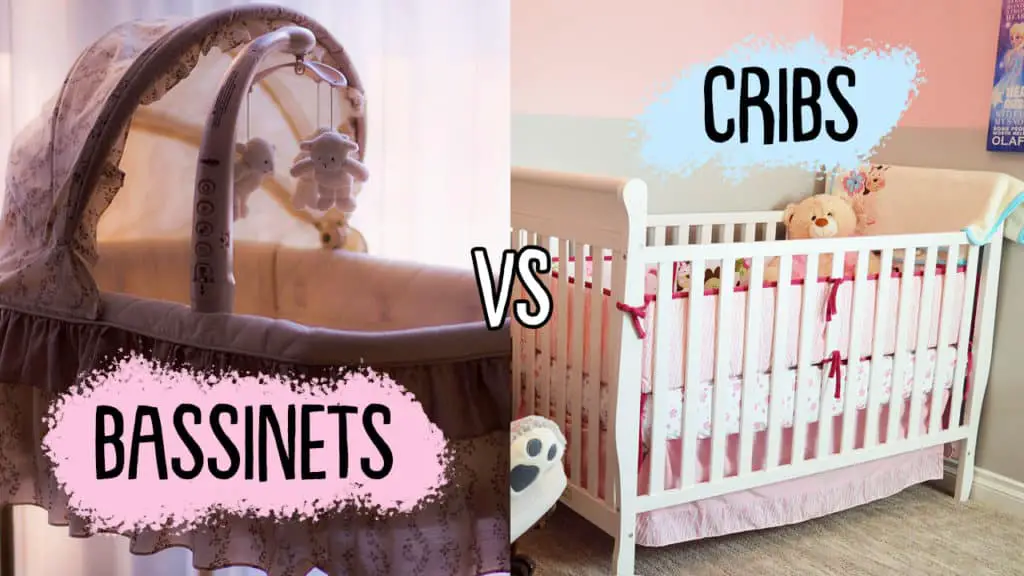As the excitement builds throughout your pregnancy, and as you count down to the day you get to bring your bundle home, you will face a lot of decisions. However, none are more important than the bassinet vs crib choice that you and your partner will need to make.
Newborn babies sleep a lot, usually between 14 and 18 hours a day, that means they will be in their sleeping space a lot! Thus, you will want to make sure they are comfortable, and most importantly, safe.
A bassinet or a crib? Which is the better choice for your baby for those all-important first few months?
Let’s take a look.

What is a Bassinet?
A bassinet is like a small basket and is often made of wicker, just like a basket. But unlike a basket, it also comes with legs and a cover, making them a bit more robust. Bassinets are for smaller babies and are suitable for newborns until they are about four months old.
Bassinets are great for co-sleeping, for moving around the house, and for lifting baby in and out in your sleepy state.

What is a Crib?
A crib is a small bed with wooden slats that form the sides and have a mattress in the bottom.
Cribs are often a stationary piece of furniture (although some come with wheels) and are less flexible than a bassinet. However, they are usually made from wood and offer a more solid solution than a bassinet.
The use of wood can be of particular importance if you have siblings or pets who may be partial to trying to reach in and see or touch the new baby.
Bassinet vs. Crib: What’s the Difference?
Bassinets and cribs are both safe choices for your newborn baby. However, both have distinctive differences you should take into account when making your choice.
The first notable difference is their sizes. A bassinet is considerably smaller than a crib and can be more space-efficient in a smaller house. You can also use it as a temporary measure if your baby came earlier than expected, and their nursery isn’t quite ready yet!
Bassinets are also more portable, making it easier for you and your partner to move around the house as you look after the inevitable piles of washing.
With lower rails, bassinets are easier for lifting your baby in and out, which is an important consideration after a C-section, when movement and ability to lift bubba will be limited.
Bassinets have a lower maximum weight allowance than cribs, and some can have maximums as low as 7-9kg. So if your baby is born around the 5kg mark, it will outgrow the bassinet quickly. Likewise, if your baby is lighter, but grows in height quickly, it could soon find itself bumping its head on the top of a bassinet.
Alternatively, cribs are a longer-term solution than a bassinet, given their bigger size. Some cribs can even be converted into a bed for your toddler, giving you years of use and better value for your money.
Where Will Baby Sleep?
Most doctors advise against co-sleeping with your baby due to the increased risk of Sudden Infant Death Syndrome (SIDS). Nonetheless, your baby can sleep next to your bed in a bassinet or a crib.
Measure the space in your master bedroom before committing to a purchase. If your bedroom is smaller, then a bassinet could be a better purchase. When taking measurements, remember you will need additional space between the crib and your bed so you can walk between the two for ease of reaching in to pick up your baby.
Other Bassinet vs. Crib Factors to Consider
One of the most significant deciding factors in the bassinet vs. crib decision comes down to cost. A bassinet is considerably cheaper than a crib. Knowing you don’t need a crib from Day 1, a bassinet can help you free up finances for other purchases you will need to prepare for the day your baby comes home.
If you first purchased a bassinet, this means you can make buying a crib part of a post-birth savings plan. This potentially gives you more time to save for that more expensive crib you’ve been eyeing for months.
Another consideration is a personal one—how it looks.
For many parents, seeing their tiny baby in a big, flat, empty crib has them feeling uneasy. Cribs are safe for newborns; however, if you follow the recommended guidelines of not having blankets or pillows in the crib—a suffocation hazard for a newborn and making you unable to lift them off—then the space can look cold and uncomfortable.
On the other hand, a bassinet is smaller and cozier, so many parents feel their baby will be more comfortable and sleep better in a more confined space.
Bassinet vs. Crib: Which is Safer?
As long as they meet the current safety standards, both a bassinet and crib are safe for your sleepy little bundle.
Whichever you choose, the mattress needs to be firm and free of any items such as pillows, blankets, and teddy bears, no matter how cute they look. The reason for this is as a newborn, your baby will wiggle and move around, and could become tangled in blankets or buried under bears. At this early stage of life, they don’t have the strength to pull the blankets off, and a tragedy can occur.
Additionally, make sure your bassinet or crib doesn’t have any cords or curtains close by, as they can be strangulation hazards.
As it’s not safe to use pillows or bolsters in the bassinet or crib, it’s essential to measure the distance between the slats, to ensure your baby’s precious head can’t fit through the gaps. For good measure, slats should be a minimum of 50mm apart and no more than 60mm apart.
If the mattress doesn’t touch the edges of the bassinet or crib, make sure there is no more than 20mm, about two fingers width, between the mattress base and each side of the bed.
Are Used Bassinets and Cribs Safe?
While it is okay to use a second hand or even an antique bed, you still need to ensure it conforms to the current safety standards. Whether the bed is new or second hand, always check the condition before use to ensure there is no damage, and that all the screws, nuts, and bolts are tight. This is especially important if you have put the bed together yourself.
If you’re going to utilize a used baby bed, it’s critical to proceed with extreme caution before you do so.
Why?
With used baby beds, there is a greater chance the bed no longer meets the most current safety standards. There is also a lot more risk of unseen damage from hairline cracks to previously unrepaired damage.
Used cribs are the riskier option. During the process of taking apart, transporting, and reassembling, pieces could have become damaged, or slats could have come loose. This poses a risk for your child to slip through the cracks. While the bed may look okay at first glance, an issue often only becomes known once it is too late, and your baby has been injured.
The general rule of thumb with used bassinets or cribs is never to use anything modified and to try and avoid using one over 10 years old.
If your budget can only stretch to a used crib or bassinet, here are some of the key things to look at before buying:
- The spacing of hard components such as slats and bars
- Mattress thickness (including abovementioned distance to edges)
- How much weight can the bassinet or crib hold?
- Height of all sides, and/or ability to raise/lower the base
- Stability
- Are all materials flameproof?
- Current ACCC Safety Standards
Bassinet vs. Crib: The Conclusion
When you’re trying to decide between a bassinet and a crib, it can feel like an overwhelming decision. That’s okay! Most parents have been there; you’re not alone.
The good news is, it really comes down to space, your budget, and your personal preference.
As long as you follow the safety guidelines to keep your baby safe, making a choice that suits your lifestyle will be the right one.
Then before you know it, it will be time to shop for their big girl or big boy bed!


